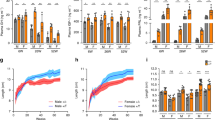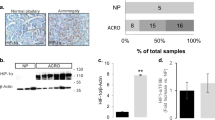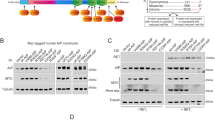Abstract
p27Kip1 (p27) controls cell cycle progression by binding to and inhibiting the activity of cyclin dependent kinases. Disruption of the p27 gene in mice (p27−/−) results in increased body growth with a disproportionate enlargement of the spleen, thymus, testis, ovary and pituitary. The increase in pituitary size is due to selective hyperplasia of the intermediate lobe (IL) while the anterior lobe (AL) is not overtly affected. p27 heterozygous mice (p27+/−), as well as p27−/− mice, are hypersensitive to radiation- and chemical-induced tumors compared to wildtype (p27+/+) littermates. Therefore, unlike classical tumor suppressors, only a reduction in p27 levels is necessary to predispose tissues to secondary tumor promoters. Consistent with these studies is the fact that the p27 gene sequence and mRNA levels appear normal in human pituitary adenomas while p27 protein levels are decreased. Therefore, a reduction in p27 levels could be sufficient to sensitize pituitary cells to tumorigenic factors. To test this hypothesis, metallothionein promoter-driven, human growth hormone-releasing hormone (MT-hGHRH) transgenic mice, that exhibit somatotrope hyperplasia before 9 months of age and subsequent adenoma formation with 30–40% penetrance, were crossbred with p27+/− mice for two successive generations to produce p27+/+, p27+/− and p27−/− mice that expressed the hGHRH transgene. At 10–12 weeks of age, p27−/− and p27+/+, hGHRH mice were larger than their p27+/+ littermates and displayed characteristic hyperplasia of the IL and AL, respectively. Expression of the hGHRH transgene in both p27+/− and p27−/− mice selectively expanded the population of somatotropes within the AL, where pituitaries of p27+/−, hGHRH and p27−/−, hGHRH mice were two- and fivefold larger than p27+/+, hGHRH pituitaries, respectively. There was also a synergistic effect of hGHRH transgene expression and p27-deficiency on liver, spleen and ovarian growth. At 6–8 months of age, 83% of p27+/−, hGHRH mice displayed macroscopic AL adenomas (>100 mg), while all pituitaries from p27+/+, hGHRH mice remained hyperplastic (<20 mg). In contrast to the dramatic effects of p27-deficiency on hGHRH-induced organ growth, elimination of p53, by crossbreeding MT-hGHRH mice to p53-deficient mice, did not augment the hyperplastic/tumorigenic effects of hGHRH transgene expression. Taken together these results demonstrate that a reduction in p27 expression is sufficient to sensitize somatotropes to the proliferative actions of excess GHRH, resulting in the earlier appearance and increased penetrance of hGHRH-induced pituitary tumors.
This is a preview of subscription content, access via your institution
Access options
Subscribe to this journal
Receive 50 print issues and online access
$259.00 per year
only $5.18 per issue
Buy this article
- Purchase on Springer Link
- Instant access to full article PDF
Prices may be subject to local taxes which are calculated during checkout




Similar content being viewed by others
References
Asa SL and Ezzat S . 1998 Endocr Rev 19: 798–827
Asa SL, Kovacs K, Stefaneanu L, Horvath E, Billestrup N, Gonzales-Manchon C and Vale W . 1990 Proc Soc Exp Biol Med 193: 232–235
Bamberger CM, Fehn M, Bamberger AM, Ludecke DK, Beil FU, Saeger W and Schulte HM . 1999a Eur J Endocrinol 140: 250–255
Bamberger AM, Riethdorf L, Milde-Langosch K, Bamberger CM, Thuneke I, Erdmann I, Schulte HM and Loning T . 1999b Virchows Arch 434: 423–428
Bilezikjian LM, Erlichman J, Fleischer N and Vale WW . 1987 Mol Endocrinol 1: 137–146
Billestrup N, Mitchell RL, Vale W and Verma IM . 1987 Mol Endocrinol 1: 300–305
Blazar BR, Brennan CA, Broxmeyer HE, Shultz LD and Vallera DA . 1995 Exp Hematol 23: 1397–1406
Blevins Jr LS, Verity DK and Allen G . 1998 Oncology 12: 1307–1312
Brar AK, Brinster RL and Frohman LA . 1989 Endocrinology 125: 801–809
Brar AK, Downs TR, Heimer EP, Felix AM and Frohman LA . 1991 Endocrinology 129: 3274–3280
Burton FH, Hasel KW, Bloom FE and Sutcliffe JG . 1991 Nature 350: 74–77
Castrillo J-L, Theill LE and Karin M . 1991 Science 253: 197–199
Coats S, Flanagan WM, Nourse J and Roberts JM . 1996 Science 272: 877–880
Copp RP and Samuels HH . 1989 Mol Endocrinol 3: 790–796
Dahia PL, Aguiar RC, Honegger J, Fahlbusch R, Jordan S, Lowe DG, Lu X, Clayton RN, Besser GM and Grossman AB . 1998 Oncogene 16: 69–76
Dana S and Karin M . 1989 Mol Endocrinol 3: 815–821
Donehower LA . 1996 Sem Cancer Biol 7: 269–278
Dyson N . 1998 Genes Dev 12: 2245–2262
Fero ML, Randel E, Gurley KE, Roberts JM and Kemp CJ . 1998 Nature 396: 177–180
Fero ML, Rivkin M, Tasch M, Porter P, Carow CE, Firpo E, Polyak K, Tsai LH, Broudy V, Perlmutter RM, Kaushansky K and Roberts JM . 1996 Cell 85: 733–744
Frohman LA and Bernardis LL . 1968 Endocrinology 82: 1125–1132
Frohman LA, Downs TR, Kashio Y and Brinster RL . 1990 Endocrinology 127: 2149–2156
Green VL, White MC, Hipkin LJ, Jeffreys RV, Foy PM and Atkin SL . 1997 Eur J Endocrinol 136: 382–387
Hammer RE, Brinster RL, Rosenfeld MG, Evans RM and Mayo KE . 1985 Nature 315: 413–416
Harwood JP, Grewe C and Aguilera G . 1984 Mol Cell Endocrinol 37: 277–284
Hengst L and Reed SI . 1996 Science 271: 1861–1864
Hengstschlager M, Braun K, Soucek T, Miloloza A and Hengstschlager-Ottnad E . 1999 Mutat Res 436: 1–9
Herman V, Drazin NZ, Gonsky R and Melmed S . 1993 J Clin Endocrinol Metab 77: 50–55
Ikeda H, Yoshimoto K and Shida N . 1997 Brit J Cancer 76: 1119–1123
Jacks T, Remington L, Williams BO, Schmitt EM, Halachmi S, Bronson RT and Weinberg RA . 1994 Curr Biol 4: 1–7
Jin L, Qian X, Kulig E, Sanno N, Scheithauer BW, Kovacs K, Young Jr WF and Lloyd RV . 1997 Am J Pathol 151: 509–519
Kato JY, Matsuoka M, Polyak K, Massague J and Sherr CJ . 1994 Cell 79: 487–496
Kiyokawa H, Kineman RD, Manova-Todorova KO, Soares VC, Hoffman ES, Ono M, Khanam D, Hayday AC, Frohman LA and Koff A . 1996 Cell 85: 721–732
Knudson AG . 1971 Proc Natl Acad Sci USA 68: 820–823
Lavia P and Janssen-Durr P . 1999 Bioessays 21: 221–230
Levine AJ . 1997 Cell 88: 323–331
Levy A, Hall L, Yeudall WA and Lightman SL . 1994 Clin Endocrinol 41: 809–814
Lidhar K, Korbonits M, Jordan S, Khalimova Z, Kaltsas G, Lu X, Calyton RN, Jenkins PJ, Monson JP, Besser GM, Lowe DG and Grossman AB . 1999 J Clin Endocrinol Metab 84: 3823–3830
Lin SC, Lin CR, Gukovsky I, Lusis AJ, Sawchenko PE and Rosenfeld MG . 1993 Nature 364: 208–213
Lloyd RV, Jin L, Chang A, Kulig E, Camper SA, Ross BD, Downs TR and Frohman LA . 1992 Am J Pathol 141: 895–906
Lloyd RV, Jin L, Qian X and Kulig E . 1997 Am J Pathol 150: 401–407
Mann DJ, Higgins T, Jones NC and Rozengurt E . 1997 Oncogene 14: 1759–1766
Mathews LS, Hammer RE, Brinster RL and Palmiter RD . 1988 Endocrinology 123: 433–437
Mayo KE, Hammer RE, Swanson LW, Brinster RL, Rosenfeld MG and Evans RM . 1988 Mol Endocrinol 2: 606–612
Medina DL, Velasco JA and Santisteban P . 1999 Endocrinology 140: 87–95
Meyer TE and Habener JF . 1993 Endocr Rev 14: 269–290
Miller TL, Godfrey PA, Dealmeida VI and Mayo KE . 1999 Endocrinology 140: 4152–4165
Miller TL and Mayo KE . 1997 79th Ann Endocrine Soc P 1–79 154 Abstract
Mori T, Kyokuwa M and Nagasawa H . 1998 Lab Anim Sci 48: 64–68
Nakayama K, Ishida N, Shirane M, Inomata A, Inoue T, Shishido N, Horii I, Loh DY and Nakayama K . 1996 Cell 85: 707–720
Pagano M, Tam SW, Theodoras AM, Beer-Romero P, Del Sal G, Chau V, Yew PR, Draetta GF and Rolfe M . 1995 Science 269: 682–685
Prives C and Hall PA . 1999 J Pathol 187: 112–126
Quaife CJ, Mathews LS, Pinkert CA, Hammer RE, Brinster RL and Palmiter RD . 1989 Endocrinology 124: 40–48
Rivard N, L'Allemain G, Bartek J and Pouyssegur J . 1996 J Biol Chem 271: 18337–18341
Robker RL and Richards JS . 1998 Mol Endocrinol 12: 924–940
Rutanen EM . 1998 Gynecol Endocrinol 12: 399–406
Sherr CJ and Roberts JM . 1999 Genes Dev 13: 1501–1512
Shiozawa T, Nikaido T, Nakayama K, Lu X and Fujii S . 1998 Mol Hum Reprod 4: 899–905
Snibson KJ, Bhathal PS, Hardy CL, Brandon MR and Adams TE . 1999 Liver 19: 242–252
Soos TJ, Park M, Kiyokawa H and Koff A . 1998 Results Probl Cell Differ 22: 111–131
Soto JL, Castrillo JL, Dominguez F and Dieguez C . 1995 Endocrinology 136: 3863–3870
Takeuchi S, Koeffler HP, Hinton DR, Miyoshi I, Melmed S and Shimon I . 1998 J Endocrinol 157: 337–341
Tanaka C, Yoshimoto K, Yang P, Kimura T, Yamada S, Moritani M, Sano T and Itakura M . 1997 J Clin Endocrinol Metab 82: 3141–3147
Thapar K, Scheithauer BW, Kovacs K, Pernicone PJ and Laws Jr ER . 1996 Neurosurgery 38: 763–770
Tong W, Kiyokawa H, Soos TJ, Park MS, Soares VC, Manova K, Pollard JW and Koff A . 1998 Cell Growth Differ 9: 787–794
Tsihlias J, Kapusta L and Slingerland J . 1999 Annu Rev Med 50: 401–423
Vlach J, Hennecke S and Amati B . 1997 EMBO J 16: 5334–5344
Xu X, Nakano T, Wick S, Dubay M and Brizuela L . 1999 Biochemistry 38: 8713–8722
Acknowledgements
The authors would like to thank Ms Geraldine V Amargo for her technical assistance in performing the radioimmunoassays and immunocytochemistry. In addition, the authors extend their appreciation to Dr AF Parlow and NHPP,NIDDK for radioimmunoassay and immunocytochemical reagents. This work was supported by NIH DK-30667 (to RD Kineman), American Cancer Society, Illinois Division #98-41 (to H Kiyokawa) and the Bane Scholar Fund (to LA Frohman).
Author information
Authors and Affiliations
Rights and permissions
About this article
Cite this article
Teixeira, L., Kiyokawa, H., Peng, X. et al. p27Kip1-deficient mice exhibit accelerated growth hormone-releasing hormone (GHRH)-induced somatotrope proliferation and adenoma formation. Oncogene 19, 1875–1884 (2000). https://doi.org/10.1038/sj.onc.1203490
Received:
Revised:
Accepted:
Published:
Issue Date:
DOI: https://doi.org/10.1038/sj.onc.1203490



